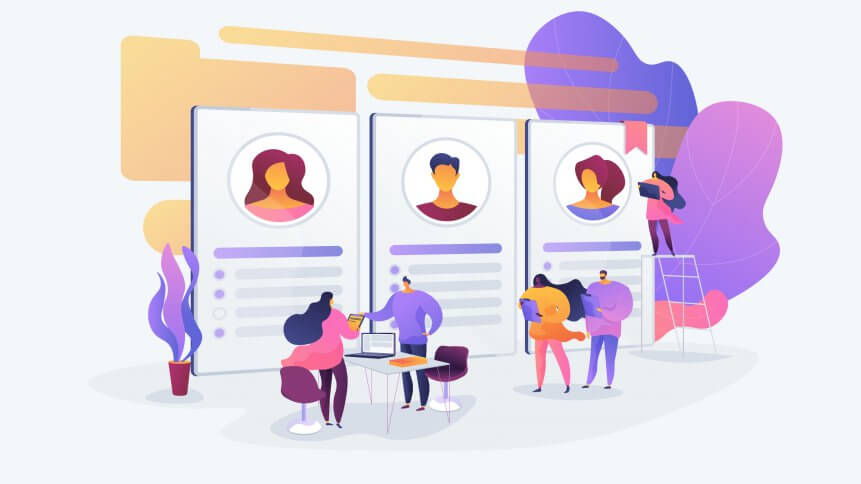AI in HR works – but not without a human element

The implementation of artificial intelligence (AI) into our daily interactions has undoubtedly made processes simpler and easier – from chatbots in our banking applications to location tools that facilitate our commutes, AI-powered solutions have been designed to create an all round better experience that suits an ever-connected, time-poor society.
Yet, as practical and effective as they are, there remains a feeling of disconnect. These tools don’t leave space for the grey areas. What happens, for instance, to the queries that aren’t programmed into your bank’s chatbot? Where’s the ‘human help’ when you need it most?
With AI playing a pivotal role in crafting business strategies focused on areas like customer acquisition, employee engagement, and supply management, it’s becoming increasingly important to look at how those grey areas can be addressed – or risk losing out on talent, profitability and success. The answer is in a balanced human-AI approach.
There’s many examples of companies that are creating digital HR strategies by harnessing the latest digital tools and features, and benefiting from the results. But a truly successful digital HR strategy needs to have a balanced mix of human touch, plus AI. Let’s explore some ways we can see the combination working better for business, keeping the employee experience at the heart of its objectives.
Decision-making attributes
A good AI engine is as effective as the initial programming criteria it was created with. For example in the recruitment cycle, once the basic indicators are filled in, the AI engine can look for internal fulfillments but there can be bias when it comes to finding the right match.
The talent pool has evolved so much with the millennial generation taking on new experiences as part of their training and learning. A search for a research analyst may throw up bias that can lead to a discrimination in the gender bias, age bias resulting in not finding the right person for the job.
How can the human element address such situations?
The human element plays a role in ensuring that the criteria in the AI framework is updated to reflect the dynamic changing scenario, socio-cultural moves as well as keeping a check on current company policies on diversity etc.
A combined approach will ensure that there are no glitches such as bias coming up with the right mix of talent pool under consideration, which ultimately helps in finding the right fit for the role.
Smart recruitment
One of the easiest ways to recruit with AI-enabled engines is the agility it shows while sifting through multiple resumes and narrowing down the best matches. There are two user case scenarios here:
The external application where a potential candidate engages with the AI feature and depends on it for information and query resolution. This process can create an impersonal experience, as the candidate does not feel connected with the employer or has no human interface to ask more questions or clarify doubts. In this case, the human angle can amplify the engagement with a call or a personalized message on the candidate’s device making it a human-digital interaction.
In the internal context, as recruiters struggle to scout for talent from within existing employees, the AI engine can serve up badly matched profiles as some of the best AI applications are not able to screen soft skills in addition to added attributes like leadership skills, culture fit etc. This is where the human angle can step in and build on the data pulled up by the AI engine. This can be the starting point to eliminate the least suitable choices in favour of the best suited ones. This combined strategy helps in enabling career growth or expansion for deserving employees.
Conflict resolution
One of the key roles played by the HR function is conflict resolution of any kind pertaining to multiple areas like compensation, issues with managers and other contentious matters. An AI application cannot bring in the creativity and problem solving approach to a serious issue where counselling the employee would be more appropriate. In these situations, while futuristic AI solutions can be programmed with more intuition and intellect, they will still need the human touch as it is all about dealing with a person, their fears, emotions and offering emphatic solutions and not just some data driven responses. A personalized approach is the only way to ensure that the employee’s issue is handled well.
Where AI can help, is in recognizing repetitive behavioral patterns that can guide working with the employee to arrive at a resolution. Analytics from previous situations can help the HR lead be more prepared, with the most effective approach.
Lack of inherent understanding
While AI is increasingly used to map and analyze multiple touchpoints in the employee life-cycle, it fails at inferring the causation aspect of two similar things or parameters. For example, they understand patterns created before feeding in certain data maps, however if they were asked to relate two kinds of patterns not within this framework, they would fail. They cannot address queries related to the ‘what would happen if this is not done?’ or vice versa. While a mature program will give some deductions, it cannot be one, that 100% of the time can lead to a resolution by tracing the cause.
When you see this in the context of dealing with people, wherein each individual operates at different levels of moral reasoning, intellect, emotional responses, the humane factor needs to step in to build on the data to find the answers. This is possible only if an individual interprets the patterns to find the answers.
Some of the key takeaways from a HR professional’s perspective is that AI is integral to creating a better, simpler way to do the same things, learn certain aspects that only deep data analytics can help provide and it will continue to evolve with more research.
The human element cannot be removed from the mix when it comes to employee engagement through a robust HR strategy. The humane aspect serves as the pivot around which AI functionalities can bring value, insights, learnings as well as value. The smartest way to use the new way of working with people is to combine these two factors and create an experience driven HR strategy, which is sustainable, smarter, outcome oriented and simply put, celebrates the human in HR.
This article was contributed by Vivek Ranjan, senior VP and chief human resource officer at Zensar.










